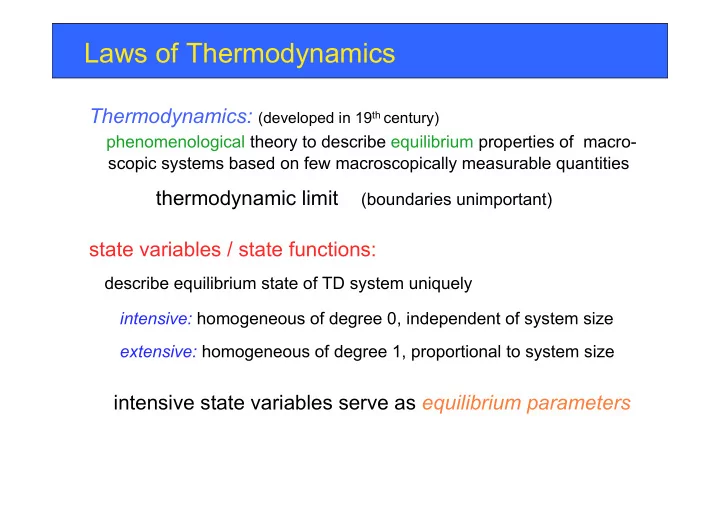

Laws of Thermodynamics Thermodynamics: (developed in 19 th century) phenomenological theory to describe equilibrium properties of macro- scopic systems based on few macroscopically measurable quantities thermodynamic limit (boundaries unimportant) state variables / state functions: describe equilibrium state of TD system uniquely intensive: homogeneous of degree 0, independent of system size extensive: homogeneous of degree 1, proportional to system size intensive state variables serve as equilibrium parameters
Laws of Thermodynamics state variables / state functions: intensive extensive S entropy T temperature V volume p pressure M magnetization H magnetic field P dielectric polarization E electric field N particle number µ chemical potential conjugate state variable: combine together to an energy T S, pV, HM, EP, µ N unit [energy]
Laws of Thermodynamics state variable: Z(X,Y) Z : exact differential
Laws of Thermodynamics Equilibrium parameters: intensive state variables can serve as equilibrium parameters Temperature (existence: 0 th law of thermodynamics ) characterizes state of TD systems „bridge“ T 1 < T 2 T 2 T 1 heat flow warmer colder Fick‘s law temperature heat gradient current
Laws of Thermodynamics Equilibrium parameters: intensive state variables can serve as equilibrium parameters Temperature (existence: 0 th law of thermodynamics ) characterizes state of TD systems „bridge“ „bridge“ T T T 2 T 1 no heat heat flow flow equilibrium warmer colder T 1 < T < T 2 Fick‘s law temperature heat gradient current
Laws of Thermodynamics Equilibrium parameters: intensive state variables can serve as equilibrium parameters Temperature (existence: 0 th law of thermodynamics ) characterizes state of TD systems „bridge“ „bridge“ T T T 2 T 1 no heat heat flow flow equilibrium warmer colder other equilibrium parameters: equilibrium parameter pressure p constant everywhere chemical potential µ in TD system
Laws of Thermodynamics Equations of state: consider TD system described by state variables subspace of equilibrium states: equation of state (EOS) Ideal gas: thermodynamic EOS Boltzmann constant
Laws of Thermodynamics Equations of state: consider TD system described by state variables subspace of equilibrium states: equation of state (EOS) Ideal gas: response functions thermodynamic EOS reaction of TD system to change of state variables isobar thermal expansion coefficient Boltzmann constant isothermal compressibility
Laws of Thermodynamics 1 st law of thermodynamics J.R. Mayer, J.P. Joule & H. von Helmhotz ~1850 „heat is like work a form of energy“ heat work displacement force specific heat gas C V : constant V paramagnet C p : constant p internal energy U isolated TD system
1 st law Laws of Thermodynamics internal energy (equipartition) ideal gas (single atomic): caloric EOS Specific heat: constant V
1 st law Laws of Thermodynamics internal energy (equipartition) ideal gas (single atomic): caloric EOS Specific heat: constant p
1 st law Laws of Thermodynamics internal energy (equipartition) ideal gas (single atomic): caloric EOS Specific heat: ideal gas: and
Laws of Thermodynamics 2 nd law of thermodynamics two equivalent formulations R. Clausius: there is no cyclic process whose only effect is to transfer heat from a reservoir of lower temperature to one with higher temperature heat heat flow ~ flow T 1 < T 2 T 1 T 2 Q Q W. Thomson (Lord Kelvin): there is no cyclic process whose effect is to take heat from a reservoir and transform it completely into work; there is no perpetuum mobile of the 2 nd kind heat work ~ flow T 1 Q W
2 nd law Laws of Thermodynamics Carnot engine reversible Carnot process T 1 Q 1 W=Q 1 -Q 2 definition of absolute temperature T ~ Q 2 irreversible process T 2 entropy as new state variable cyclic process Clausius‘ reversible theorem cyclic process irreversible
2 nd law Laws of Thermodynamics entropy ideal gas: reversible isothermal process dU=0 p coupled to work reservoir V 2 V 1 B A irreversible process B V 2 increase of entropy V 1 A waste of potential energy
2 nd law Laws of Thermodynamics application to gas: dS exact differential S(U,V) caloric EOS thermodynamic EOS
Laws of Thermodynamics Thermodynamic potentials natural state variables convenient simple relations internal energy (gas) U(S,V) and response functions: specific heat adiabatic compressibility dS=0
Laws of Thermodynamics Thermodynamic potentials natural state variables convenient simple relations internal energy (gas) U(S,V) and Maxwell relations: dU exact differential
Laws of Thermodynamics Thermodynamic potentials natural state variables convenient simple relations other variables: (S,V) (T,V) Legendre transformation F(T,V) Helmholtz free energy (gas) specific heat response functions isothermal compressibility
Laws of Thermodynamics Thermodynamic potentials natural state variables convenient simple relations other variables: (S,V) (T,V) Legendre transformation F(T,V) Helmholtz free energy (gas) Maxwell relation
Laws of Thermodynamics Thermodynamic potentials natural state variables convenient simple relations H(S,p) Enthalpy (gas) Maxwell relation G(T,p) Gibbs free energy (gas) Maxwell relation
Laws of Thermodynamics Equilibrium condition general S maximal entropy: in equilibrium U,V fixed variables closed system: dU=dV=0 potential fixed variables T,V F minimal T,p G minimal S,V U minimal S,p H minimal
Laws of Thermodynamics 3 rd law of thermodynamics Nernst 1905 S = S(T,q,…) entropy e.g.: independent of T, q, … S 0 = 0 only within quantum statistical physics Planck:
Recommend
More recommend